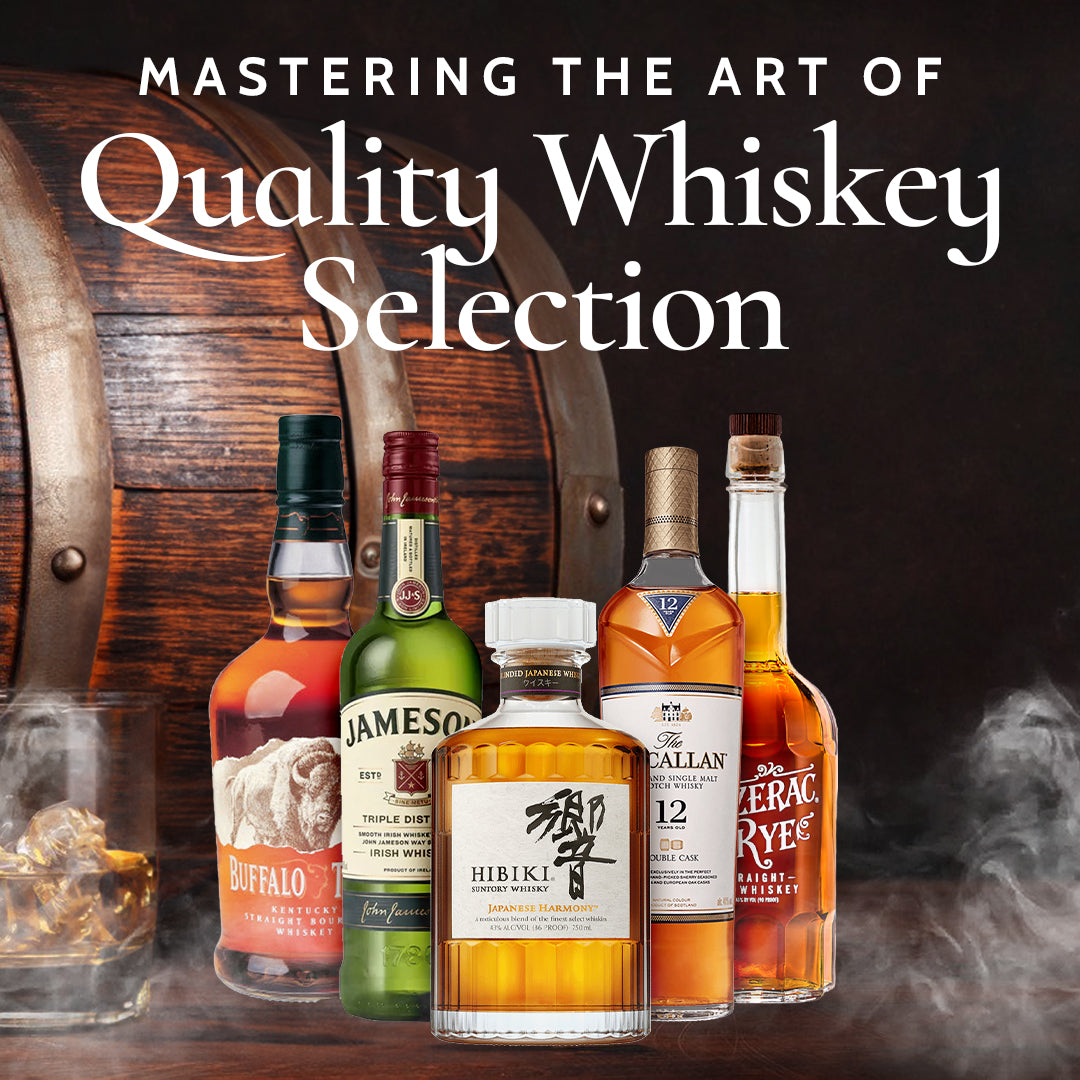Whiskey, with its diverse flavors and rich history, has become a beloved spirit worldwide. It is a distilled alcoholic beverage crafted mostly from fermented barley, rye, wheat, and corn. Each bottle of whiskey has a unique flavor, aroma, and complexity that result from the intricate procedures of fermentation, distillation, and maturation in wooden barrels.
The quality of whiskey greatly influences the taste and experience of drinking it. But how can you distinguish between good whiskey and bad whiskey before making a purchase? With a world of whiskeys to discover, from American Bourbons to Irish Whiskeys, it can be pretty challenging to determine which whiskey to pick. In this comprehensive guide, we'll explore the key factors and expert tips to help you differentiate between good and bad whiskey and ensure you choose a bottle that satisfies your palate.
Understanding the Types of Whiskey
Before we dive into the nuances of identifying good whiskey from bad whiskey, it's essential to grasp the different types of whiskey available. The main types include:

Hailing from Scotland (spelled without an "e"), Scotch whisky can be categorized into blended Scotch and single malt. Blended Scotch combines whiskies from multiple distilleries, while single malt is made from malted barley at a single distillery.

Made from a blend of malted and unmalted barley, Irish whiskey is renowned for its smooth and approachable flavor profile.

Bourbon, America's contribution to the whiskey world, must be aged in new charred oak barrels and have a mash bill that contains at least 51% corn.

Rye whiskey, often associated with Canada and the United States, is made from at least 51% rye grain in its mash bill.

Japanese whisky draws inspiration from Scotch whisky and has gained global acclaim for its meticulous craftsmanship and exceptional balance of flavors.
Other well-liked whiskeys include Canadian and Tennessee, each with distinctive qualities and production techniques.
Key Factors for Distinguishing Whiskey Quality
1. Read Labels Carefully: Deciphering Whiskey Bottle Information
One of the easiest ways to discern the quality of whiskey is by reading the label. Whiskey labels provide crucial information about the spirit, including its origin, age, and proof. Here are some key details to look for:
- Age: The age statement mentioned on the label indicates how long the whiskey has been aged in wooden barrels. Generally, older whiskeys tend to have more complex flavors.
- Alcohol by Volume (ABV): The ABV percentage can tell you how strong the whiskey is. This percentage can greatly influence a whiskey's quality. While a higher ABV doesn't necessarily equate to better quality, it may influence your preference. Some enthusiasts prefer higher-proof whiskeys (often over 50% ABV) because they contain a more intense flavor profile. Lower-proof whiskeys (around 40% ABV) are great options for those new to whiskey.
- Origin: The place of origin also significantly influences a whiskey's quality. Different regions have different traditions, climate conditions, and regulations that may affect the production process as well as the final taste profile. For example, bourbons tend to have sweeter, full-bodied profiles, while Scotch whiskies have smoky, peaty flavors due to the use of peat in the malting process.
- Limited Editions: Limited edition releases are often highly sought after by collectors and enthusiasts. While they can be pricier, they often offer exceptional tasting experiences.
2. Age Matters
The age of whiskey can significantly impact its quality and flavor. Whiskeys are typically aged in wooden barrels, usually oak, and during this process, they interact with the wood extracting flavors and characteristics.
Whiskeys aged for a shorter period, typically around three to five years, tend to have a more pronounced grainy or alcoholic flavor. These can be excellent for cocktails. On the other hand, whiskeys aged for a longer duration, say ten years or more, often have a smoother, more refined taste, featuring a longer finish. The aging process allows the spirit to lose its harsher flavor and become more complex and full-bodied.
The ideal age for whiskey depends on personal preference. Some prefer the subtleties of a well-aged whiskey, while others savor the boldness of a younger one.
3. Appearance Insights
The first step in physically judging a whiskey is by visually examining it. While appearance alone doesn't determine taste, it can hint at how well the whiskey has been crafted.
Observe the color of the whiskey to gain insight into its quality. Generally, darker hues suggest longer aging or the use of wine or sherry casks, while lighter shades often indicate shorter aging. However, color alone isn't a guarantee of quality. You should also consider checking for clarity.
High-quality whiskey should be clear and free from any impurities or sediment. Hazy or cloudy whiskey may indicate subpar production or filtration issues. Consistency is also essential. A 'leggy' whiskey – where the spirit produces streaks down the side of the glass – can indicate a fuller-bodied whiskey.
4. The Sniff Test
A whiskey's "nose" or aroma is a crucial aspect of its quality. Swirl the whiskey gently in your glass and take a moment to inhale its aroma and identify the different scents. High-quality whiskey should have a complex, layered aroma that often features notes of fruits, spices, grains, and perhaps a hint of oak. If the smell of the whiskey is overpowering, it may be a sign that it's poorly balanced or has a high proof.
5. Sip and Savor
The moment of truth in evaluating the quality of a whiskey comes with tasting. Sip the whiskey slowly, allowing it to coat your tongue and palate. Pay close attention to the taste. A good whiskey should not be dominated by one flavor. It should be well-balanced with a harmonious interplay of flavors.
6. Texture and Finish
The finish refers to the sensory experience and flavors that linger in your mouth after you've swallowed the whiskey. It's the final impression the spirit leaves, and it can encompass various sensations, including taste, warmth, and complexity. A good whiskey leaves a lingering and satisfying finish, with flavors that evolve pleasantly, while a bad whiskey often has a short or unpleasant finish. Additionally, quality whiskey offers a smooth and well-balanced mouthfeel, while bad whiskey may feel harsh, astringent, or overly grainy.
7. Assessing Distillery Reputation
The distillery's reputation can serve as a valuable indicator when distinguishing between good and bad whiskey. Distilleries with a history of producing high-quality spirits and a strong commitment to craftsmanship often produce premium whiskey. When you encounter a whiskey produced by a respected distillery, it's usually a promising sign that the spirit you're considering is of high quality and worth exploring.
8. Expert Opinions and Reviews
When seeking to differentiate between good whiskey and bad whiskey, expert opinions and reviews can be invaluable resources. Whiskey enthusiasts, professional critics, online whiskey communities, or experienced bartenders can offer valuable insights that can guide your purchasing decisions. You can also seek advice and recommendations from friends, family, or acquaintances who share your interest in whiskey.
Top-Shelf Whiskeys You'll Certainly Love










Conclusion
Distinguishing good whiskey from bad whiskey before making a purchase involves a combination of factors, including evaluating labels, considering age, and the brand's reputation. By using the above guidelines and exploring your palate preferences, you'll be well-equipped to choose a whiskey that not only meets but also surpasses your expectations.
Keep in mind that whiskey appreciation is a personal journey, and the most essential thing is purchasing bottles that align with your palate and bring joy to your drinking experience. The quality of a particular whiskey can be subjective and is highly influenced by personal taste.
As a result, whiskey exploration should be an enjoyable and exciting journey filled with experimentation. Don't be afraid to trust your palate when buying whiskey. After all, "good whiskey" is the one you actually enjoy.
FAQs
Are There Specific Regions Known for Producing Exceptionally Good Whiskey?
Yes, regions like Ireland, Scotland, and Kentucky are renowned for producing high-quality whiskey due to their distinct terroir and production methods.
Is It Better to Buy a Blended Whiskey or a Single Malt for Quality?
The choice between blended whiskey and single malt depends on your taste preferences. Both can offer high quality, but they have different flavor profiles.
What Are the Common Flaws to Watch Out for in a Bad Whiskey?
Common flaws in bad whiskey include unpleasant or excessive bitterness, overpowering alcohol burn, extreme smokiness or off-putting aromas like mustiness.
How Can I Develop My Palate to Appreciate the Nuances of Whiskeys?
Developing your palate involves tasting different whiskeys and paying attention to their aromas, tastes and finishes. Attending whiskey tastings and joining whiskey groups can also help.

